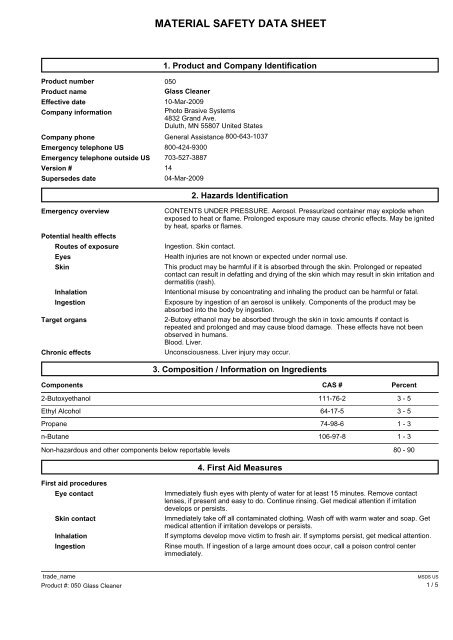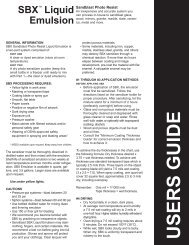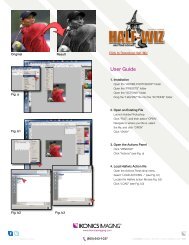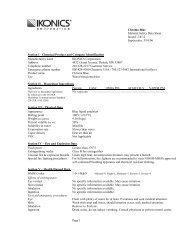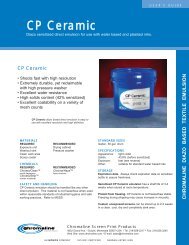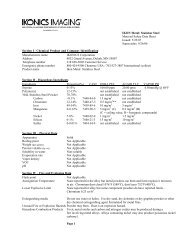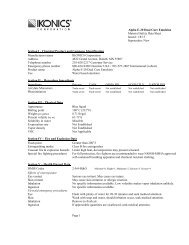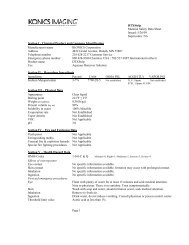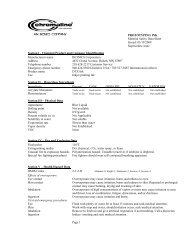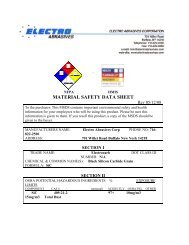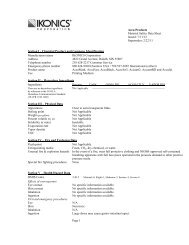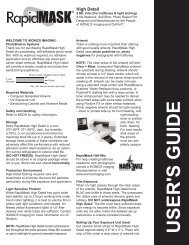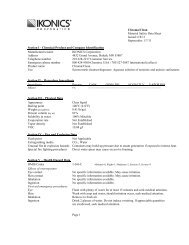MSDS 050 - Glass Cleaner
MSDS 050 - Glass Cleaner
MSDS 050 - Glass Cleaner
You also want an ePaper? Increase the reach of your titles
YUMPU automatically turns print PDFs into web optimized ePapers that Google loves.
.<br />
.<br />
.<br />
.<br />
MATERIAL SAFETY DATA SHEET<br />
1. Product and Company Identification<br />
space<br />
Product number <strong>050</strong><br />
space<br />
Product name<br />
Gleme <strong>Glass</strong> <strong>Cleaner</strong> <strong>Glass</strong> <strong>Cleaner</strong><br />
space<br />
Effective date<br />
10-Mar-2009<br />
space<br />
Company information<br />
Claire Photo Manufacturing Brasive Systems Co.<br />
500 4832 Vista Grand Ave. Ave.<br />
Addison, Duluth, MN IL 60101 55807 United States<br />
space<br />
Company phone General Assistance 800-643-1037<br />
630-543-7600<br />
space<br />
Emergency telephone US 800-424-9300<br />
space<br />
Emergency telephone outside US 703-527-3887<br />
space<br />
Version # 14<br />
space<br />
Supersedes date<br />
04-Mar-2009<br />
space<br />
Emergency overview<br />
space<br />
Potential health effects<br />
Routes of exposure<br />
space<br />
space<br />
space<br />
space<br />
space<br />
Eyes<br />
Skin<br />
Inhalation<br />
Ingestion<br />
Target organs<br />
space<br />
Chronic effects<br />
2. Hazards Identification<br />
CONTENTS UNDER PRESSURE. Aerosol. Pressurized container may explode when<br />
exposed to heat or flame. Prolonged exposure may cause chronic effects. May be ignited<br />
by heat, sparks or flames.<br />
Ingestion. Skin contact.<br />
Health injuries are not known or expected under normal use.<br />
This product may be harmful if it is absorbed through the skin. Prolonged or repeated<br />
contact can result in defatting and drying of the skin which may result in skin irritation and<br />
dermatitis (rash).<br />
Intentional misuse by concentrating and inhaling the product can be harmful or fatal.<br />
Exposure by ingestion of an aerosol is unlikely. Components of the product may be<br />
absorbed into the body by ingestion.<br />
2-Butoxy ethanol may be absorbed through the skin in toxic amounts if contact is<br />
repeated and prolonged and may cause blood damage. These effects have not been<br />
observed in humans.<br />
Blood. Liver.<br />
Unconsciousness. Liver injury may occur.<br />
3. Composition / Information on Ingredients<br />
space<br />
Components<br />
2-Butoxyethanol<br />
Ethyl Alcohol<br />
Propane<br />
n-Butane<br />
Non-hazardous and other components below reportable levels<br />
CAS #<br />
111-76-2<br />
64-17-5<br />
74-98-6<br />
106-97-8<br />
Percent<br />
3 - 5<br />
3 - 5<br />
1 - 3<br />
1 - 3<br />
80 - 90<br />
space<br />
First aid procedures<br />
space<br />
space<br />
space<br />
Eye contact<br />
Skin contact<br />
Inhalation<br />
Ingestion<br />
4. First Aid Measures<br />
Immediately flush eyes with plenty of water for at least 15 minutes. Remove contact<br />
lenses, if present and easy to do. Continue rinsing. Get medical attention if irritation<br />
develops or persists.<br />
Immediately take off all contaminated clothing. Wash off with warm water and soap. Get<br />
medical attention if irritation develops or persists.<br />
If symptoms develop move victim to fresh air. If symptoms persist, get medical attention.<br />
Rinse mouth. If ingestion of a large amount does occur, call a poison control center<br />
immediately.<br />
trade_name<br />
Product #: <strong>050</strong> <strong>Glass</strong> Revision <strong>Cleaner</strong> date: 10-MAR-2009 Print date: 10-MAR-2009<br />
<strong>MSDS</strong> US<br />
1 / 5
.<br />
.<br />
.<br />
.<br />
.<br />
space<br />
Flammable properties<br />
space<br />
Extinguishing media<br />
Suitable extinguishing media<br />
space<br />
Protection of firefighters<br />
space<br />
Protective equipment and<br />
precautions for firefighters<br />
Methods for containment<br />
space<br />
Methods for cleaning up<br />
5. Fire Fighting Measures<br />
Vapor or gas may spread to distant ignition sources and flash back.<br />
Water fog. Foam. Dry chemical powder. Carbon dioxide (CO2).<br />
Containers should be cooled with water to prevent vapor pressure build up.<br />
6. Accidental Release Measures<br />
Eliminate all ignition sources (no smoking, flares, sparks, or flames in immediate area).<br />
Stop leak if you can do so without risk. Move the cylinder to a safe and open area if the<br />
leak is irreparable. Stop the flow of material, if this is without risk. Prevent entry into<br />
waterways, sewers, basements or confined areas.<br />
Should not be released into the environment. Use a non-combustible material like<br />
vermiculite, sand or earth to soak up the product and place into a container for later<br />
disposal.<br />
Small Spills: Wipe up with absorbent material (e.g. cloth, fleece). Clean contaminated<br />
surface thoroughly.<br />
space<br />
Handling<br />
space<br />
Storage<br />
7. Handling and Storage<br />
Pressurized container: Do not pierce or burn, even after use. Do not handle or store near<br />
an open flame, heat or other sources of ignition. Use only in area provided with<br />
appropriate exhaust ventilation. Do not use if spray button is missing or defective. Do not<br />
get this material in contact with eyes. Do not get this material in contact with skin. Avoid<br />
prolonged exposure.<br />
Level 1 Aerosol.<br />
Contents under pressure. Do not puncture, incinerate or crush. Keep away from heat,<br />
sparks, and flame. Do not expose to heat or store at temperatures above 120°F/49°C as<br />
can may burst. Avoid exposure to long periods of sunlight. Keep out of the reach of<br />
children. Do not store, incinerate, or heat this material above 120 degrees Fahrenheit.<br />
8. Exposure Controls / Personal Protection<br />
space<br />
Exposure limits<br />
ACGIH<br />
Components CAS #<br />
TWA<br />
STEL<br />
Ceiling<br />
2-Butoxyethanol 111-76-2<br />
20 ppm<br />
Not established Not established<br />
Ethyl Alcohol 64-17-5 1000 ppm Not established Not established<br />
Propane 74-98-6 1000 ppm Not established Not established<br />
n-Butane 106-97-8 1000 ppm Not established Not established<br />
space<br />
space<br />
OSHA<br />
Components CAS #<br />
TWA<br />
STEL<br />
Ceiling<br />
2-Butoxyethanol 111-76-2<br />
50 ppm<br />
Not established Not established<br />
Ethyl Alcohol 64-17-5 1000 ppm Not established Not established<br />
Propane 74-98-6 1000 ppm Not established Not established<br />
space<br />
space<br />
Personal protective equipment<br />
space<br />
space<br />
Eye / face protection<br />
Skin protection<br />
Respiratory protection<br />
Wear chemical goggles.<br />
Wear appropriate chemical resistant gloves. Wear appropriate chemical resistant<br />
clothing.<br />
When workers are facing concentrations above the exposure limit they must use<br />
appropriate certified respirators. If permissible levels are exceeded use NIOSH<br />
mechanical filter / organic vapor cartridge or an air-supplied respirator.<br />
space<br />
Appearance<br />
9. Physical & Chemical Properties<br />
Compressed liquefied gas.<br />
trade_name<br />
Product #: <strong>050</strong> <strong>Glass</strong> Revision <strong>Cleaner</strong> date: 10-MAR-2009 Print date: 10-MAR-2009<br />
<strong>MSDS</strong> US<br />
2 / 5
.<br />
.<br />
.<br />
.<br />
.<br />
space<br />
Boiling point<br />
space<br />
Color<br />
space<br />
Flammability (HOC)<br />
space<br />
Flash back<br />
space<br />
Flash point<br />
space<br />
Form<br />
space<br />
Odor<br />
206.6 °F (97.2 °C) estimated<br />
Colorless.<br />
3.7946 kJ/g estimated<br />
No<br />
-156 °F (-104.4 °C)<br />
Aerosol.<br />
Butyl<br />
space<br />
pH 9.5 - 10.5<br />
space<br />
Physical state<br />
space<br />
Pressure<br />
space<br />
Solubility<br />
space<br />
Specific gravity<br />
Liquid.<br />
66 - 76 psig @ 70F<br />
Completely<br />
0.9572 estimated<br />
10. Chemical Stability & Reactivity Information<br />
space<br />
Chemical stability<br />
space<br />
Conditions to avoid<br />
space<br />
Incompatible materials<br />
space<br />
Hazardous decomposition products<br />
space<br />
Acute effects<br />
space<br />
Sensitization<br />
space<br />
Reproductive effects<br />
space<br />
Teratogenicity<br />
space<br />
Ecotoxicity<br />
Stable at normal conditions.<br />
Heat, flames and sparks.<br />
None known.<br />
No hazardous decomposition products are known.<br />
11. Toxicological Information<br />
Acute LD50: 5684 mg/kg estimated, Rat, Dermal<br />
Not expected to be hazardous by OSHA criteria.<br />
Not expected to be hazardous by OSHA criteria.<br />
Not expected to be hazardous by OSHA criteria.<br />
12. Ecological Information<br />
Components of this product have been identified as having potential environmental<br />
concerns.<br />
LC50 28957 mg/L estimated, Fish, 96.00 Hours,<br />
EC50 43419 mg/L estimated, Daphnia, 48.00 Hours,<br />
IC50 12207 mg/L estimated, Algae, 72.00 Hours,<br />
space<br />
Waste codes<br />
space<br />
Disposal instructions<br />
13. Disposal Considerations<br />
D001: Waste Flammable material with a flash point
.<br />
space<br />
IMDG<br />
space<br />
IATA<br />
Basic shipping requirements:<br />
Proper shipping name<br />
Hazard class<br />
UN number<br />
Additional information:<br />
Packaging exceptions<br />
Item<br />
Labels required<br />
Transport Category<br />
Basic shipping requirements:<br />
Proper shipping name<br />
Hazard class<br />
UN number<br />
Additional information:<br />
Packaging exceptions<br />
Labels required<br />
AEROSOLS<br />
2.1<br />
1950<br />
LTD QTY<br />
5F<br />
None<br />
2<br />
Aerosols, flammable<br />
2.1<br />
1950<br />
LTD QTY<br />
2.1<br />
15. Regulatory Information<br />
space<br />
US federal regulations<br />
This product is a "Hazardous Chemical" as defined by the OSHA Hazard Communication<br />
Standard, 29 CFR 1910.1200.<br />
U.S. - CERCLA/SARA - Section 313 - Emission Reporting<br />
2-Butoxyethanol<br />
111-76-2 1.0 % de minimis concentration (applies to R-(OCH2CH2)n-OR', where n = 1,2, or 3,<br />
R=alkyl C7 or less, or R = phenyl or alkyl substituted phenyl, R' = H or alkyl C7 or<br />
less, or OR' consisting of carboxylic acid ester, sulfate, phosphate, nitrate, or<br />
sulfonate, Chemical Category N230)<br />
space<br />
Occupational Safety and Health Administration (OSHA)<br />
29 CFR 1910.1200 hazardous Yes<br />
chemical<br />
space<br />
CERCLA (Superfund) reportable quantity<br />
None<br />
space<br />
Superfund Amendments and Reauthorization Act of 1986 (SARA)<br />
space<br />
space<br />
space<br />
Hazard categories<br />
Section 302 extremely<br />
hazardous substance<br />
Section 311 hazardous chemical Yes<br />
Immediate Hazard - Yes<br />
Delayed Hazard - Yes<br />
Fire Hazard - Yes<br />
Pressure Hazard - Yes<br />
Reactivity Hazard - No<br />
No<br />
Inventory status<br />
Country(s) or region Inventory name On inventory (yes/no)*<br />
space<br />
China<br />
Europe<br />
Europe<br />
Japan<br />
Korea<br />
United States & Puerto Rico<br />
Inventory of Existing Chemical Substances in China (IECSC)<br />
European Inventory of New and Existing Chemicals (EINECS)<br />
European List of Notified Chemical Substances (ELINCS)<br />
Inventory of Existing and New Chemical Substances (ENCS)<br />
Existing Chemicals List (ECL)<br />
Toxic Substances Control Act (TSCA) Inventory<br />
A "Yes" indicates that all components of this product comply with the inventory requirements administered by the governing country(s)<br />
State regulations<br />
U.S. - Pennsylvania - RTK (Right to Know) List<br />
2-Butoxyethanol<br />
111-76-2 Present<br />
Ethyl Alcohol<br />
64-17-5 Present<br />
n-Butane<br />
106-97-8 Present<br />
Propane<br />
74-98-6 Present<br />
No<br />
Yes<br />
Yes<br />
No<br />
No<br />
Yes<br />
trade_name<br />
Product #: <strong>050</strong> <strong>Glass</strong> Revision <strong>Cleaner</strong> date: 10-MAR-2009 Print date: 10-MAR-2009<br />
<strong>MSDS</strong> US<br />
4 / 5
.<br />
16. Other Information<br />
space<br />
Further information<br />
space<br />
HMIS® is a registered trade and service mark of the NPCA.<br />
HMIS® ratings Health: 1<br />
Flammability: 1<br />
Physical hazard: 0<br />
space<br />
Disclaimer<br />
The information provided in this Safety Data Sheet is correct to the best of our<br />
knowledge, information and belief at the date of its publication. The information given is<br />
designed only as a guidance for safe handling, use, processing, storage, transportation,<br />
disposal and release and is not to be considered a warranty or quality specification. The<br />
information relates only to the specific material designated and may not be valid for such<br />
material used in combination with any other materials or in any process, unless specified<br />
in the text.<br />
space<br />
<strong>MSDS</strong> sections updated<br />
This document has undergone significant changes and should be reviewed in its entirety.<br />
trade_name<br />
Product #: <strong>050</strong> <strong>Glass</strong> Revision <strong>Cleaner</strong> date: 10-MAR-2009 Print date: 10-MAR-2009<br />
<strong>MSDS</strong> US<br />
5 / 5


